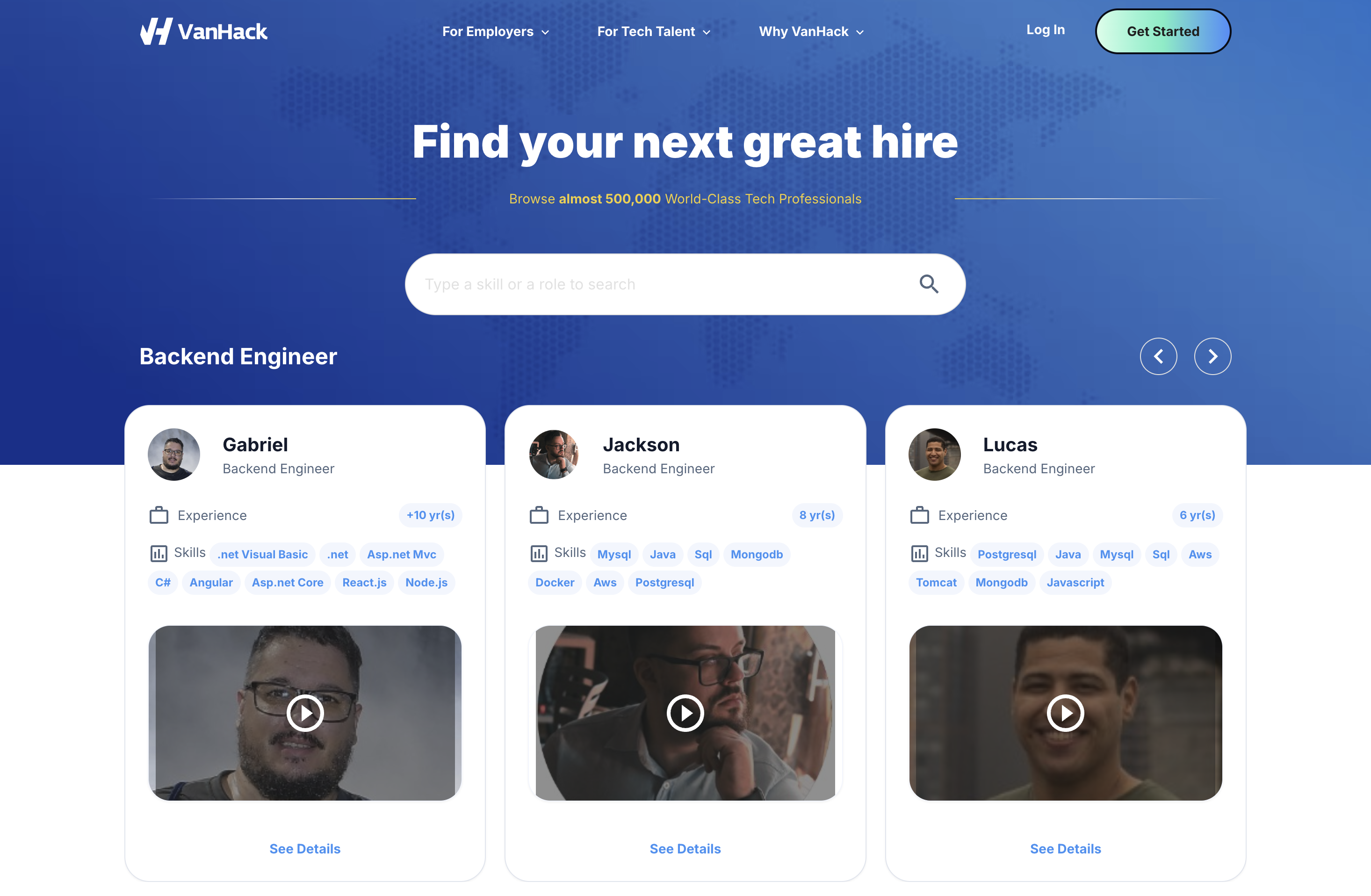Hiring remote software developers from Latin America offers US companies a powerful way to scale with skilled talent. The region provides a strong mix of technical expertise, overlapping time zones, cultural compatibility, and cost advantages. But accessing this talent pool means taking a thoughtful approach to international hiring, beyond just posting a job listing.
If you’re a hiring manager, HR professional, CTO, or engineering VP at a growing startup, your goal isn’t just to find developers. You want the right developers, quickly, while managing the challenges of cross-border recruitment. This guide shares seven practical strategies to help you build high-performing engineering teams with LATAM talent. Recruit faster with VanHack and tap into Latin America’s skilled developers.
1. Craft Job Descriptions That Attract Remote LATAM Talent
Your job description is the first impression for potential candidates. To connect with LATAM developers, it needs to speak directly to their interests and motivations for remote work with US companies.
Start by clearly stating that the role is remote and your company supports flexible, trust-based work. Use straightforward language, avoiding jargon that might not resonate across cultures. Highlight benefits that matter to international candidates, such as USD-based pay, learning opportunities, flexible hours across time zones, and exposure to advanced technologies.
Be specific about technical requirements. List the exact tech stack, programming languages, and frameworks you need, like React, Node.js, or Python. This helps attract developers with matching skills, as many in LATAM have deep experience with popular tools.
Add a section explaining why a LATAM developer would fit well in your company. Showcase your focus on diversity, inclusivity, and global teamwork. If you already have international team members, mention this to prove your experience with distributed teams. This builds trust and draws in stronger candidates.
2. Use Targeted Platforms to Source LATAM Talent
General job boards can bring in too many applications, often from unqualified candidates, wasting your team’s time. Instead, focus on platforms tailored for remote work and LATAM developers, where the talent is already relevant to your needs.
Specialized agencies like South connect US companies with vetted remote LATAM developers, guiding you through the hiring process for quality matches. These partners know the local market and save you effort in sourcing.
For direct hiring, prioritize platforms focused on remote roles. Sites like We Work Remotely, Remote OK, FlexJobs, Working Nomads, and Remotive attract LATAM developers seeking remote positions. These platforms cater to professionals ready for distributed work.
Look for tools that offer pre-screening or compliance help. Some platforms check candidates for technical skills, English level, and remote readiness, cutting down your initial review time. Platforms with detailed profiles, including portfolios and test results, are especially useful.
Don’t forget professional networks. LinkedIn works well for targeted searches and direct outreach. Partnerships with coding bootcamps and universities in LATAM can also help you connect with up-and-coming talent.
3. Streamline Hiring with AI-Driven Vetting Tools
Manual vetting takes time and can introduce bias when evaluating candidates from diverse backgrounds. AI tools offer a faster, fairer way to assess skills and communication, giving you deeper insights with less effort.
Choose AI systems that evaluate multiple skills at once. Look for options testing coding through real challenges, problem-solving with scenarios, and English skills via interactive tasks. These assessments paint a clearer picture of a candidate’s potential than just resumes or short calls.
Advanced AI platforms provide detailed data. Video introductions let you gauge communication and language skills in minutes, skipping unnecessary early interviews. Recorded technical sessions show problem-solving and coding approaches for async review by your team.
Partners like VanHack make this process even smoother. Their ‘Vanna’ AI recruiter offers video intros, 30-minute technical interviews with transcripts and scores, plus coding test results from trusted tools like Woven. This comprehensive method speeds up hiring with clear candidate insights. VanHack helps you find the right talent quickly.

4. Gain Full Support Through Expert Recruitment Partners
Handling international hiring in-house can strain your team, especially at fast-paced startups. From sourcing to compliance, the process is complex. Recruitment firms focused on LATAM talent can speed up hiring and reduce risks with end-to-end support.
Top firms do more than find candidates. They offer pre-vetted talent, manage initial screenings, and provide guidance throughout hiring. Revelo links US companies with over 400,000 screened LATAM engineers, handling payroll, taxes, and compliance for easier cross-border hiring.
VanHack’s ‘All You Can Hire’ subscription, powered by Vanna, costs a flat $3,000 monthly for unlimited hires. This approach cuts costs compared to per-hire fees, ideal for teams scaling fast.
VanHack also includes a Global Mobility service. Beyond placement, their in-house team manages immigration and relocation, from visa processing to finding housing and schools. This full support helps you hire talent wherever they are. Start hiring with VanHack for efficient international recruitment.
5. Offer Attractive Pay and Work-Life Balance
To hire and keep top LATAM developers, your compensation must match their value in a competitive global market. While cost savings can be a factor, focus on building a strong overall package, not just low rates.
Know the market benchmarks for fair offers. Junior to mid-level remote LATAM developers often earn $3,000 to $4,200 USD yearly, with higher pay for senior or specialized roles. Rates vary by skills, experience, and job complexity.
Senior developers with niche skills demand more. Common languages in LATAM include JavaScript, Python, Java, PHP, and Ruby. Expertise in tools like React, Node.js, or AWS often means higher pay expectations.
Add benefits that resonate with remote LATAM talent. Offer training budgets, conference access, or certification support. Provide flexible hours respecting time zones, with reasonable overlap for US teams. Highlight career growth paths within a US company.
Consider extras like equity, health benefits, mental health support, home office allowances, or yearly team meetups to strengthen team bonds.
6. Strengthen Your Employer Brand for Global Talent
In a competitive remote market, your employer brand can set you apart. LATAM developers have many US opportunities, so show why your company is a great place for global talent to grow.
Review your brand from an international perspective. Ensure your careers page, social media, and messaging emphasize remote work and diversity. Share stories from current remote or LATAM team members to build trust and show real inclusivity.
Visuals count. Use website images and materials that reflect diversity. If you have LATAM staff, feature them. If not, highlight your commitment to global collaboration and remote best practices.
Create content for LATAM developers. Write blog posts on remote work tips, technical topics by your engineers, or project case studies. Engage on platforms they use, like LinkedIn, GitHub, Stack Overflow, and local tech groups. Join virtual LATAM tech events or contribute to open-source projects to boost visibility.
Be open about your remote culture. Share details on tools, meeting habits, and maintaining team unity across time zones. This clarity helps candidates decide if they fit and shows your distributed team experience.
7. Focus on Smooth Onboarding for Long-Term Success
How you onboard remote LATAM hires shapes their productivity and satisfaction. A solid process gets them up to speed faster and improves retention, making it a key part of international hiring.
Build a detailed remote onboarding plan beyond paperwork. Include tech setup guides so new hires have equipment, software, and environment access from day one. Document how your team uses tools, covering communication, code reviews, and workflows.
Work on cultural fit with structure. Pair new hires with a mentor for technical and social guidance in early weeks. This buddy helps with questions and team norms in a remote setting.
Set regular check-ins beyond the first week. Schedule talks at one week, one month, and three months to track progress, solve issues, and get feedback. Cover technical and cultural integration to ensure full support.
Create regional support networks. VanHack, for example, uses local WhatsApp groups for relocated hires to build community. For remote staff, connect them with peers in similar time zones for added belonging.
Train your team on cross-cultural communication. Equip managers to handle different styles and avoid misunderstandings, fostering an inclusive space for everyone.
VanHack vs. Others: Why We’re Your Best Choice for LATAM Hiring
Navigating the LATAM hiring market means understanding your options based on needs, budget, and timeline. Solutions range from agencies and freelance sites to job boards and full-service platforms, each with unique benefits and drawbacks.
|
Feature |
VanHack |
Traditional Agencies |
Freelance Platforms |
|
Cost Model |
Flat Fee ($3k/month) or Success Fee |
15-25% of Annual Salary |
Ongoing Platform Margins |
|
Talent Focus |
Pre-vetted Senior Tech Talent |
Broad/Unfocused Pool |
Global Freelancers |
|
Vetting Process |
AI Video Intros + Tech Interviews |
Basic Resume Screening |
Self-Reported Skills |
|
Global Mobility |
Full In-House Relocation Service |
No Support Provided |
No Support Provided |
VanHack’s subscription through Vanna costs $3,000 monthly for unlimited hires, offering predictable savings. One company hired seven developers for $9,000, versus over $100,000 with agency fees.
VanHack’s vetting uses AI assessments, video intros, technical interviews, and coding tests for detailed profiles. Their Global Mobility service supports the full hiring cycle, including relocation help. Find top talent with a complete solution for scaling US teams.
Frequently Asked Questions About Hiring LATAM Developers
What programming languages and frameworks are common among LATAM developers?
LATAM developers are skilled in many in-demand technologies for US projects. JavaScript leads for web development, followed by Python for backend, data science, and machine learning. Java is widely used in enterprise and Android work.
PHP and Ruby are also common, with expertise in frameworks like Laravel, Symfony, and Ruby on Rails. Modern tools like React and Node.js are popular, fitting current web needs. Cloud and DevOps skills, including AWS, Azure, Docker, and Kubernetes, are on the rise.
The region’s tech scene keeps evolving. Developers are adopting TypeScript, Vue.js, Angular, React Native, and Flutter, showing flexibility for diverse project needs and tech stacks.
What are typical salary ranges for remote LATAM developers?
Pay for remote LATAM developers depends on experience, skills, and location. Junior to mid-level roles often range from $3,000 to $4,200 USD per year, usually for entry-level or less experienced positions.
Senior developers with over five years of experience or niche skills earn more, typically $40,000 to $80,000+ yearly for US remote roles. Full-stack experts in JavaScript frameworks, cloud tech, or data engineering fall in this range.
Top senior talent with proven records and strong English skills often matches mid-level pay in smaller US markets. While cost differences exist, high-quality hires expect competitive pay reflecting global remote standards.
How does VanHack manage legal and tax issues for international hires?
VanHack supports direct hires, making candidates your employees, not contractors, for better control. For remote roles, companies usually hire as independent contractors, with VanHack offering contract and compliance advice.
For relocation, VanHack’s Global Mobility team handles immigration, guiding visa processes for candidates and families, from paperwork to approval. They also assist with housing, schools, and settling in, letting hires focus on work while companies offer relocation without internal legal expertise.
Conclusion: Build Your Team Faster with VanHack
Hiring remote LATAM developers gives US companies a valuable chance to grow engineering teams effectively. The strategies in this guide, from refining job postings to using AI vetting and ensuring smooth onboarding, create a clear path to this talent pool.
Success comes from adapting to international hiring needs, not just using local methods. Companies that learn the market, refine processes, and work with experienced partners see better results in candidate fit and hiring speed.
VanHack tackles key challenges of global hiring with AI matching, thorough vetting, and relocation support. Their subscription model and market knowledge make them a strong ally for building LATAM-powered teams.
Ready to improve your hiring and access Latin America’s skilled developers? Start hiring with VanHack today and see how specialized tools and expertise can shape your next engineering team.



